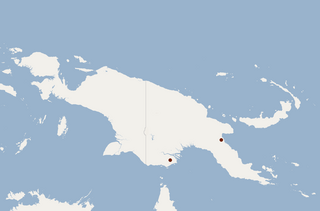
Gould's long-eared bat is a microbat found in southern regions of Australia. It occurs in eastern Australia, from Queensland to Victoria, and in a smaller isolated range in the south-west of Western Australia.

Nyctophilus arnhemensis, known as the northern or Arnhem long-eared bat, is a species of Chiroptera (bats) native to northern regions of Australia. The distribution range is from north-western Queensland to northern Western Australia.

The eastern long-eared bat, species Nyctophilus bifax, is a small flying mammal, a vespertilionid bat. It is found in eastern Australia and Papua New Guinea.

Nyctophilus geoffroyi is a vespertilionid bat. a flying nocturnal mammal found in Australia, The species is relatively common. They have been referred to as the lesser long-eared bat.

The Lord Howe long-eared bat was a vespertilionid bat known only by a single specimen, a skull found on Lord Howe Island in 1972. A mammalian insectivorous species resembling the long-eared Nyctophilus, with an elongated head that is comparatively larger, about which almost nothing is known. The bat may have been casually observed in flight during the twentieth century, but is likely to have become extinct since the island's discovery and occupation. The demise of N. howensis is possibly the result of shipwrecked rats and the owls introduced to control them.

The small-toothed long-eared bat is a species of vespertilionid bat found only in Papua New Guinea.

The New Guinea long-eared bat is a small species of bat. It is found only in Papua New Guinea.

The south-eastern long-eared bat or Corben's long-eared bat, is a species of bat found in Australia. It occurs in the woodlands of the Murray Darling Basin and adjacent areas.

The pygmy long-eared bat is a vesper bat, found in the north of the Australian continent. An insectivorous flying hunter, they are one of the tiniest mammals in Australia, weighing only a few grams and one or two inches long.
The southern forest bat is a vesper bat found in Australia.

The Vespertilioninae are a subfamily of vesper bats from the family Vespertilionidae.
The New Caledonian long-eared bat is a vesper bat found in New Caledonia. They are only recorded at Mount Koghis, near Nouméa, and the population is decreasing.
Nyctophilus daedalus is a species of bat in the family Vespertilionidae, a flying mammal endemic to northern Australia. They are also referred to as the pallid long-eared bat or northern long-eared bat.

The Mount Missim long-eared bat is a species of vesper bat found in Papua New Guinea.

The Tasmanian long-eared bat is a species of vesper bat endemic to Tasmania.

Nyctophilus major, referred to as a western long-eared bat, is a species found in forests and woodlands of Southwest Australia.
The Holts' long-eared bat is a species of bat in the family Vespertilionidae. It is endemic to Australia, where it is only found in the southwestern corner of Western Australia.

Vespertilionini is a tribe of bats in the family Vespertilionidae. The largest of the tribes in Vespertilioninae, it contains many genera found throughout the Old World and Australasia.













